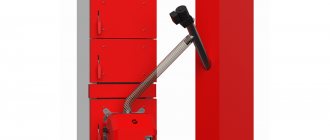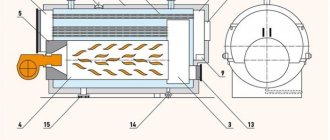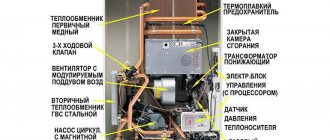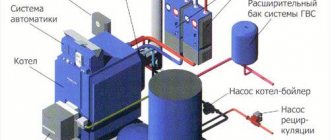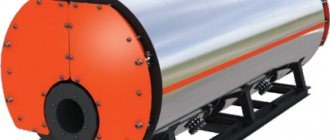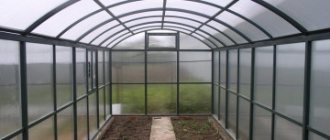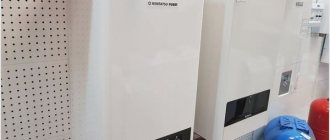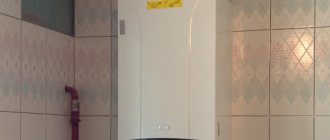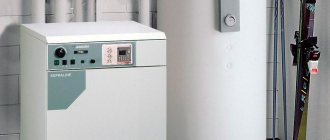A home heating boiler using solid fuel and electricity is designed to heat buildings without centralized heating. It is convenient because energy consumption is regulated independently.
A combined heating boiler is needed to heat buildings.
What are solid fuel and electric boilers?
All combined models are divided according to the following parameters:
- number of circuits;
- supported fuel types;
- type of combustion chamber.
Scope of application
The range of use of the units is small; they are mainly purchased for heating houses where there is no other heating, as well as in saunas or baths.
Combination boiler design
All heat generators consist of:
- steel body painted with heat-resistant paint;
- combustion chambers;
- heat exchanger;
- smoke exhaust systems;
- an ash pit separated from the firebox by grates;
- protective, adjustment, control and measuring instruments (these include pressure gauges, temperature sensor, drain pipe, pressure relief valve, gate lock, heat limiter).
Solid fuel boiler design.
Specifications
Basic data includes:
- Thermal power during operation.
- Electrical energy consumed.
- Weight, dimensions.
Principle of operation
The operation of combined units consists of the following stages:
- Fuel is added to the combustion chamber and ignited. After which the water is heated, its temperature is regulated by a thermostat. At this stage, the heating elements do not work.
- After burning a batch of wood or coal, the water begins to cool. When the minimum value is reached, the sensor is triggered and the heaters are turned on.
- If you add a new portion of fuel, the device operates without electricity.
Design and principle of operation
In the design and operating principle of combined heating devices, there are various schemes that differ in their actions. Two types of heating system operate simultaneously and parallel to each other:
- in the first scheme, the electric heater is in the lead; gas equipment is connected only to increase the power and water temperature;
- in the other, on the contrary, gas equipment takes the leading position, and an electric heater is used as support.
We recommend: How to install an induction heating boiler?
Combined heating boilers for heating a house can be of several types:
- a device using gas as the dominant fuel. Such heating equipment is used to heat a room having a large area. In this device, an electric heater is used to increase the temperature in the system;
- Considering a combined electric boiler as a leader, you can understand that its operating principle is the same as that of electric boiler equipment. When the temperature drops in the system, the gas burner is automatically switched on. For example, during a power outage;
- Boiler equipment that has two heating elements operating simultaneously (gas and electricity) has a complex operating process. Such equipment is very economical and efficient.
When choosing a device, it is necessary to take into account its functions, architectural features of the building and area. If for some reason it is not possible to install the equipment yourself, then it is better to invite a specialist who will help install the device and use it without consequences.
Advantages of combi boilers
Benefits include:
- Cheap fuel. Wood waste is used.
- Economical.
- A reliable automation system that controls the operation of the unit in the absence of a person.
- The coolant heats up quickly, and the loss coefficient is minimal.
- There is no need to heat at night, because... The heating elements automatically turn on and provide a continuous heating process.
- Multi-fuel models provide for the use of firewood, coal and peat.
- The service life is 20 years.
The advantages of combined boilers include efficiency.
Pros and cons of a combined heating system
Considering combined gas and electric heating boilers, their characteristics and capabilities, one cannot help but note some advantages of using the equipment:
- Equipment efficiency reaches 95%;
- Due to its small size, installation of the device is easier;
- minimum degree of contamination by emissions into the atmosphere;
- due to the possibility of combining types of heating, the consumption of both is reduced;
- boiler equipment can automatically switch between two types of heating, successfully combining different types;
- double-circuit boiler equipment. Has the ability to combine room heating and water heating;
- Over time, the cost of the equipment pays off.
We recommend: waste oil heaters
Minuses:
- When connecting this type of boiler equipment with your own hands, you must coordinate your actions with the relevant authorities. Since the connection method is a three-phase network;
- cannot be used in apartments. Only on private property;
- if we compare gas heating, then this type of equipment costs 65% more;
- Constant supervision is required - tech. service and prof. work.
Combined heating boilers (gas, electricity)
Disadvantages of equipment
Disadvantages of heating devices:
- High price.
- Large dimensions. The devices are made only floor-standing due to the wood-burning firebox. They will need a separate room.
- The need to install a chimney and forced ventilation.
- Large mass of cast iron firebox.
- The equipment will require a foundation or concrete pad.
- The power limit of the heating element is no higher than 30 kW.
- A complex device that increases the complexity of installation and the cost of repairs.
Multi-fuel boilers and electrical installations - which is better?
To buy suitable equipment, you need to focus on the following criteria:
- Place of installation (house or apartment).
- Area of heated premises.
Electrical appliances are small in size and are hung on the wall to save space. They do not require a special room, chimney, or hood, because... they do not emit harmful substances into the atmosphere. Disadvantages include high energy consumption, the need to install separate wiring, and energy dependence. Such units are recommended for use in apartments or as a backup system.
Multi-fuel boilers are small in size.
Multi-fuel devices are convenient because they support different raw materials:
- firewood;
- coal;
- peat;
- wood waste;
The presence of a heating element will protect you in the absence of solid fuel.
Recommendations when choosing a boiler
Today the market offers a wide range of universal boilers, which differ in power, performance, design and configuration. But before purchasing such a unit, you need to weigh the pros and cons, and it is also useful to listen to the recommendations of professionals in this matter.
When purchasing a boiler, you must consider the following:
- Power . It depends on the fuel that will be a priority.
- The volume of one fuel load and the size of the combustion chamber . The duration of firewood burning depends on this parameter.
- Firebox material . These parts are made of cast iron and steel. It is preferable to choose chambers made of cast iron, since they are not subject to deformation when heated and retain heat longer, unlike a steel exchanger.
Components for combined boilers Source winplast.ru
- Grate bars . Two types are used: standard cast iron and the same, but coated with ceramic. The latter are used mainly for bulk materials, which consume more oxygen during combustion, and accordingly, the temperature is created higher.
- Weight and size . Typically, the body of such boilers is made of cast iron, which makes them much heavier than their “brothers”.
Advice! When buying a heating device, you need to take into account the area of the house. You should not purchase a boiler “with a power reserve”, as this will entail an overpayment - both during purchase and during operation.
Selecting a combi boiler
To purchase suitable heating equipment, you need to consider the following parameters:
- Type of energy carrier.
- Dimensions.
- Technical characteristics (power).
- Efficiency
- Number of circuits.
- Firebox dimensions. This parameter affects how often it loads.
Possibility of connecting a water circuit
The combined equipment has a special structure, due to which the coolant quickly heats up. In addition, a boiler is connected to the units. Some models provide for the connection of a “warm floor” system, which will allow additional heating of the premises.
A boiler can be connected to the combined equipment.
Heat exchanger material
This device is considered an important design element, because heats the water to the required parameters. When choosing heating equipment, you should pay attention to the material from which the heat exchanger is made:
- Steel is most often used because... this metal is easy to process and has a low cost. Such devices are resistant to high temperatures and do not deform during operation. The advantages of steel heat exchangers include maintainability, low weight, and low cost.
- Cast iron is used only in floor-standing models. Such devices are resistant to high temperatures and have a long service life. Disadvantages include the need for cleaning, large weight and size, which complicates replacement.
- An alloy of aluminum with silicon (silumin) is resistant to aggressive environments. This type of heat exchanger is used in floor-standing equipment. The disadvantage is sensitivity to the composition of water, which affects the protective layer. Therefore, only filtered liquid can be used.
- Copper is considered the best material, because... It is lightweight, corrosion resistant and durable. The main disadvantage is the high cost.
Required power
This parameter is considered the most important, because a weak boiler will not provide a comfortable temperature, and if the power is exceeded, fuel consumption increases and water can boil, which reduces the service life of the equipment. So, to heat 10 m², 1 kW of heat energy is used. It is recommended to make allowances for the height of the rooms, the number of storeys of the building and the thickness of the walls and leave a reserve of 0.5 kW.
Boiler power is an important parameter.
Type of solid fuel
There are many types of consumables for combined equipment:
- Firewood. Their heat transfer depends on humidity and wood type.
- Pellets are granules with a diameter of 8 mm and a length of up to 5 cm. They are produced by pressing waste wood, straw, corn, etc. They are highly effective and popular in European countries.
- Fuel briquettes (eurowood). Made from wood processing waste under pressure at a temperature of +260°C. This creates durable bars that are similar in texture to firewood.
- Coal. Has high calorific value. Disadvantages include ash content and environmental pollution.
- Peat. It is formed by rotting plants at high humidity in swampy areas in the absence of oxygen. The main advantages are simple storage conditions and affordable price.
Availability of safety valve
When choosing solid fuel boilers, it is important to pay attention to the safety device.
Its main function is to ensure safe operation and eliminate accidents that occur when water overheats and pressure increases.
Fuel chamber size
The devices are available with various parameters. The frequency of filling depends on the dimensions of the firebox. In small chambers you have to add fuel more often, and this is inconvenient, especially at night.
The size of the fuel chamber varies.
Dimensions and weight of the boiler
The combined appliance is large in size and weight due to the firebox, which is often made of cast iron. Therefore, it is worth determining the installation location in advance.
Description and capabilities of double-circuit boilers
For houses and cottages located in the countryside, the ideal option would be double-circuit gas-electric boilers due to the following advantages:
- Less gas consumption;
- the cost of a double-circuit heat generator is higher than a single-circuit one, but lower when compared with the cost of equipment with a single circuit and an integrated boiler;
- simultaneous heating of hot water and coolant occurs;
- Less space is required for installation due to its compact size, which allows installation in the kitchen or in the furnace room, but subject to compliance with all norms and requirements.
But there are also disadvantages here:
- the consumption of gas, electricity and water must be balanced;
- if the flow of hot water decreases with unregulated gas, the temperature increases;
- It will be necessary to reconfigure the equipment if the pressure in the water supply network changes;
- periodic maintenance is necessary, since with hard water carbonate deposits quickly form on heat exchangers, which generally leads to decreased performance or breakdown;
- When you turn on the tap, cold water will flow for about 30 seconds.
Advice! It is worth understanding that all the disadvantages of double-circuit gas-electric boilers depend on the technical characteristics and manufacturer. When purchasing heating equipment, it is better to use the services of a specialist.
Requirements for installation of a combi boiler
Such units are considered dangerous equipment, so their placement must comply with the required standards.
Room
The following rules are established for the location:
- The walls in the boiler room must be made of non-combustible materials.
- The boiler is located 300 mm from the walls.
- Dry room.
- Cement screed under the unit.
- It is prohibited to place flammable materials near the boiler.
- It is necessary to install a metal sheet in front of the firebox to prevent fires from sparks or dropped fuel.
Chimney
A combined heating system requires the installation of a pipe to remove harmful substances. For stable combustion you need good draft, for this the chimney is installed higher than the roof. Its diameter must be no less than that of the boiler pipe. A hermetically sealed connection at the joints is necessary to avoid smoke in the room. In the cold season, it is recommended to insulate the chimney.
A combined heating system requires the installation of a chimney.
Circuit
The universal device provides for the operation of a heating element, so it is better to make a separate wiring for it that will withstand the existing power.
The connection of the unit must be carried out by certified specialists.
What are the installation requirements?
Connecting electric gas boilers must comply with certain standards and regulations, and you must also follow the attached instructions from the manufacturer. Depending on the design, installation can be floor or wall.
In any case, regardless of the device, the following requirements must be observed during installation work:
- according to fire safety conditions, the walls and floor of the room intended for the installation of a gas-electric heating boiler must be insulated, for example, with a sheet of metal;
- when working, you must be guided by the connection diagram issued by the gas service employees;
- when using several sources of thermal energy connected in parallel, free access to each must be ensured;
- the system must be connected to a protected electrical network (grounded and isolated);
- when installing a chimney, it is mandatory to maintain the distance from the walls; all requirements can be found in the technical data sheet;
- the circulation pump is selected taking into account the length of the utility network and the diameter of the pipes;
- Only threaded types of connections are allowed to be used;
- dual-circuit designs involve the use of filters for water purification for each circuit.
If you follow the rules for connecting electric gas boilers, there will be no problems with performance, efficiency, fire safety, uninterrupted operation, and high efficiency is also guaranteed.
Well-known manufacturers of solid fuel and electric boilers
There are many manufacturers of equipment for private homes that produce various models.
"Teplodar Cooper Praktik 14"
2021 model with 14 kW power. The heating area is 140 m². Combined type - solid fuel, built-in heating elements. Suitable for any system.
"Teplodar Cooper Praktik 14" heats 140 m².
"Karakan 16TPEV 3"
A powerful long-burning boiler is designed for heating rooms up to 160 m². Made from 3 mm sheet steel. The device has 2 circuits and runs on the following types of fuel:
- firewood;
- wood waste;
- peat;
- coal;
- electricity.
The second circuit is designed to heat water for domestic needs. There is a hob on the top panel.
"Teplodar Cooper OVK 18"
A solid fuel boiler with a heating element heats rooms with an area of 100 m² to 180 m². The upper part is the cooking surface. Connection is made on the right and left sides. It is possible to install a gas burner. A 2 year warranty is provided.
"Teplodar Kupper OVK 18" is a solid fuel boiler.
Lamborghini Calor el DB DN EVO 32
The heat generator works with gas or diesel burners. The body is made of cast iron with steel elements. These boilers are reliable and easy to operate. The advantages include:
- low fuel consumption;
- stylish design;
- compactness.
- The kit includes additional Lamborghini burners of the EKO, FIRE, EM series.
Ferroli Atlas EVO 47
A single-circuit boiler with a floor-mounted forced-air burner has a cast-iron heat exchanger. The model is equipped with digital control. Runs on gas and diesel fuel. There is a liquid freeze protection function.
Ferroli Atlas EVO 47 is a single-circuit boiler.
Buderus Logano G125
The floor-standing electric boiler is made of cast iron and operates on liquid fuel. Available in 25 kW, 32 kW and 40 kW power outputs. The burner is set at the factory, so it works immediately after switching on. A boiler connection is provided.
"Evan Warmos TT 18"
A modern solid fuel device has an improved design that ensures safe surface temperatures, low weight and good thermal power.
"Evan Warmos TT 18" is a solid fuel device.
ACV Delta Pro S 25
The device runs on gas and liquid fuel. The model is equipped with an indirect heating system using “tank in tank” technology. The equipment has a large heat exchange surface area.
Installation Rules
Installation of any equipment requires compliance with a list of rules and compliance with safety standards. The same must be done with combined heating. Based on the design features, the device is installed on the floor or mounted on the wall.
It doesn’t matter what type of installation will be used, the installation rules are the same:
- to create a fire-safe environment in the room, the walls and floor are covered with materials that are not afraid of fire, for example, iron sheets;
- when connecting to gas, you must follow the instructions issued by the gas service;
- for boiler equipment with a parallel connection, a free approach is provided;
- the electrical connection is made with grounding and mandatory insulation;
- installation of the chimney is carried out in compliance with the standards specified in the technical passport;
- the pump is purchased taking into account the volume of the water heating system and the thickness of the pipe;
- the connection type must be threaded only;
- It is also advisable to install water filters.
Wall-mounted double-circuit boilers
The device will work at its maximum efficiency if the connection with a combination of gas and electric heating is taken into account at the design stage. In the case of installation and commissioning of equipment, the work will be carried out by a professional craftsman, this also increases the life and quality of operation of gas-electric equipment.
Following simple rules will help maintain equipment performance. The device will work efficiently. Compliance with fire safety standards will eliminate accidental problems. Timely maintenance of combined equipment will ensure uninterrupted operation, and the efficiency will be at a high level and will remain constant.
YouTube responded with an error: The request cannot be completed because you have exceeded your quota.
- Related Posts
- How do combined solid fuel heating boilers work?
- How does an induction electric boiler work for heating a private home?
- How to make a hydrogen heating boiler?
- How does the Miratron induction heating boiler work?
- Features of repair of heating boilers
- How to install an induction heating boiler?
Reviews of combination boilers
Tatyana, 60 years old, Bataysk
My husband built a 2-story house on a summer cottage. There is a small fireplace on the 2nd floor, but it is not enough to heat the entire building. It's cold on the 1st floor. Then we bought a boiler. Since there is no gas supply or central heating to the house, and there are rare interruptions in electricity, we had to buy a combined type.
The most affordable boiler for us turned out to be a solid fuel boiler with heating element. There were no problems with the installation, because... We had a small extension to the house that was suitable for a boiler room. We are satisfied with the operation of the boiler; the heating elements turn on at night, so there is no need to get up and add firewood. I also regulate the temperature and electricity consumption myself.
Anatoly, 38 years old, Pskov
I was skeptical about combined models due to their high cost and large dimensions. But my brother only recommended this type. I liked it because of the possibility of using waste wood or coal. And when you are too lazy to heat, the electric heating turns on. Now I plan to install a “warm floor”.
Evgeniy, 39 years old, Rostov
I have had a solid fuel boiler for 10 years. During all this time there were no breakdowns, I am satisfied with the quality of the material. He equipped a boiler room especially for him. The area of my house is 85 m², it is fully heated. Since my wife and I have 3 children, we connected the heated floor. I'm happy with everything.
